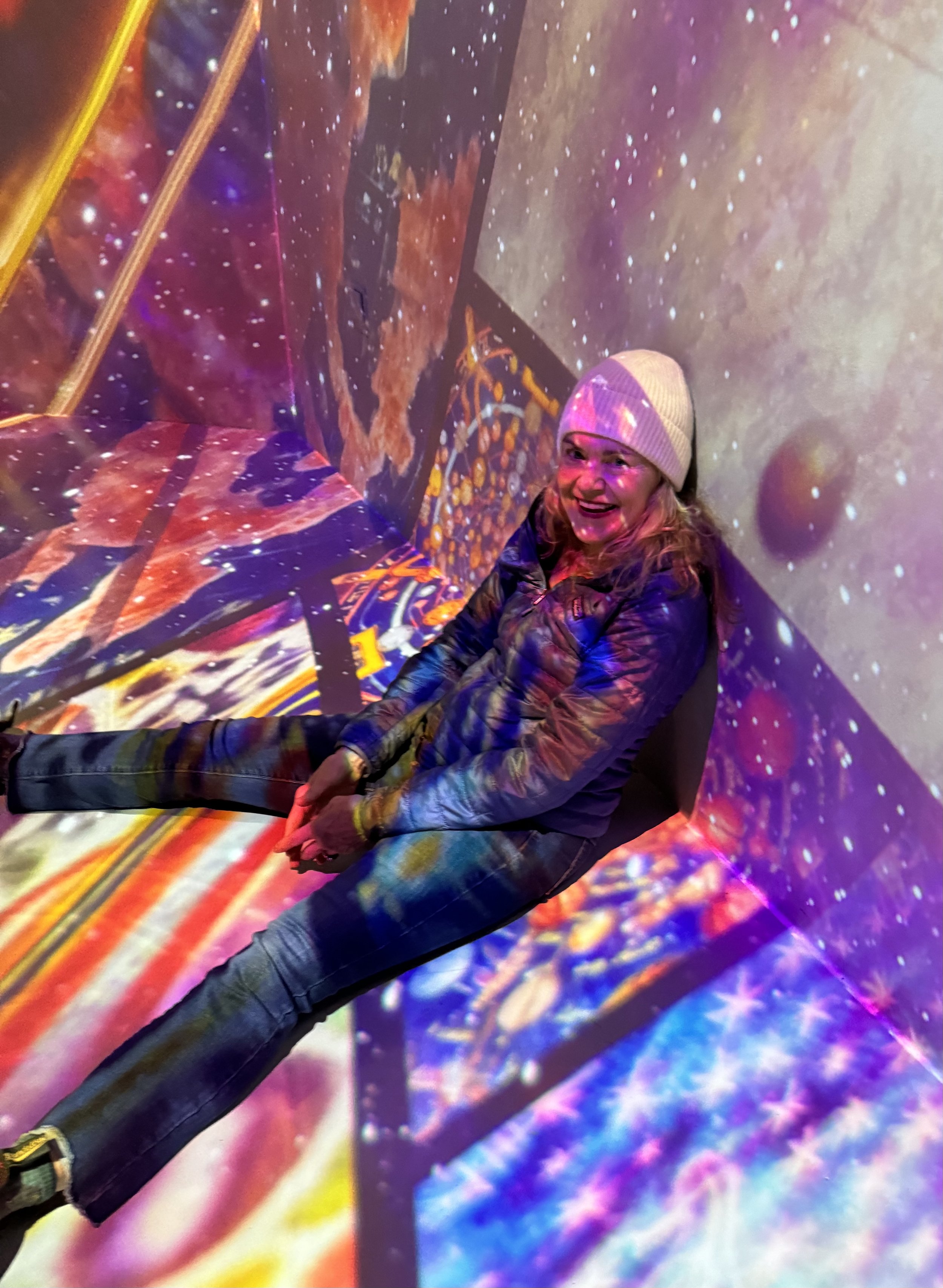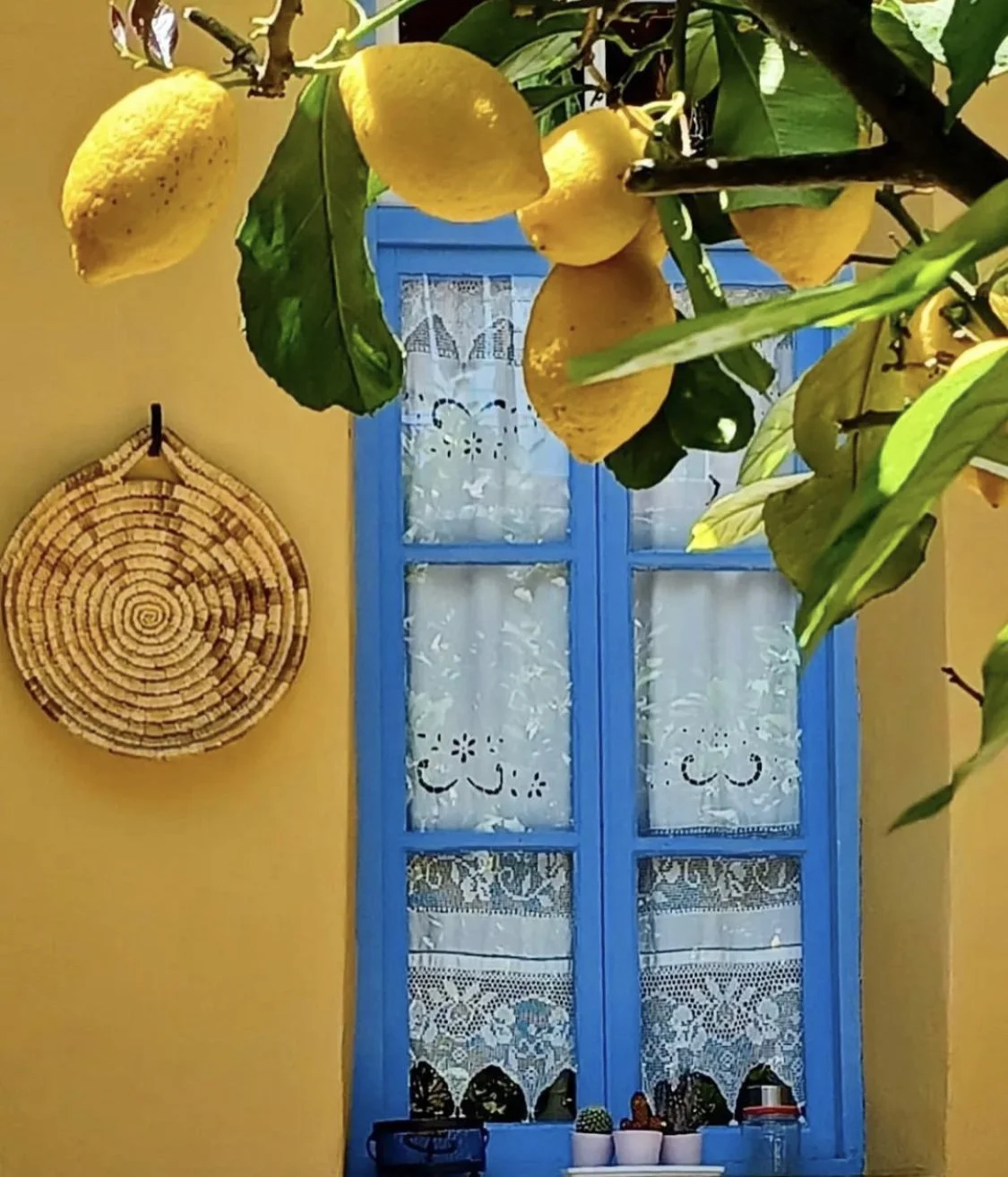Adventure: Albania & Vienna
Tirana, Republic of Albania 2024
Albania is a stunning country with an emerging economy—a price-positive tourist destination to consider now, before everyone else gets there. After the deadly 2019 earthquake, the E.U. invested more than forty million euros in restoring Albania’s cultural heritage, including the Soviet-style architecture of the capital, Tirana. A quirky, fun city, it boasts an ambitious food scene and was crowned the European Youth Capital of 2022. In April we flew Montreal-Vienna then jumped on a Ryanair quickie flight to deliver us to Tirana, the capital city of Albania. (We wanted to spend a few days in Vienna post bike trip, and this was a great flight plan to accommodate our timing.) Albania is located in Southeast Europe on the Balkan Peninsula; she is bordered by Montenegro to the northwest, Kosovo to the north, North Macedonia to the east, and Greece to the south. To the west, her coastline runs along the Adriatic Sea, and to the southwest along the Ionian Sea. With a population of nearly three million people, this dramatic country features an exquisite and diverse landscape of mountains, beaches, and forests.
We explored colorful Tirana on a rainy April weekend and found the heart of Albania pulsing with a powerful blend of old soul and cutting-edge vibes. Tirana has transformed dramatically since her communist state era (1946-1991). The city center is ever evolving with a mix of Ottoman, Soviet, and Contemporary architecture all learning to live amicably alongside each other. The newly constructed buildings are painted in vibrant primary colors that made me smile; the public squares, gardens, and streets are classical and a pleasure to wander without a plan. Albania has an ambitious, scrappy attitude—it is an emerging economy and the citizens, especially their youth, want more for their futures. Albania is slated to join the EU soon, and we wanted to visit while it was still a little sleepy on the tourist radar. We are very glad we did. Not only is this friendly and beautiful country very budget friendly, but the food is ridiculously fresh and plentiful, and the hard working citizens are kind and effusive in their hospitality—a cultural mandate.
Go now! Book in at the Radisson/Morina for the lovely lake setting and extraordinary food, it's an easy walk to the trendy Blloku district where everyone is shopping or just relaxing in the charming cafes people watching. Make sure to dine at the local favorite ‘Eras’ restaurant for a true Albanian cultural experience. We had a superb meal including multiple local dishes such as qofte (pistacchio dusted meatballs), fërgesë (a dish made with peppers, tomatoes, and cheese), tave kosi (baked lamb with yogurt), and a fresh sorrel green fettuccini (that I am still dreaming about)—four adults with beverages, for $53USD. If you are planning a trip to Albania I suggest you read In Albania's Tourism Revival, Food Plays a Central Role from Condé Nast Traveler.
Tirana offers a blend of rich history, vibrant culture, and stunning natural landscapes. Here are some things to do when visiting Tirana:
1. Skanderbeg Square: Start your exploration of Tirana at its central square, named after Albania's national hero, Skanderbeg. Admire the monumental Skanderbeg statue and the historic Et'hem Bey Mosque, which dates back to the 18th century.
2. BunkArt 2: Dive into Albania's communist past by visiting BunkArt 2, a museum housed in a massive underground bunker. The museum showcases exhibits and multimedia installations that provide insight into the country's history during the communist era.
3. Mount Dajti National Park: Take a cable car ride to the top of Mount Dajti for breathtaking panoramic views of Tirana and the surrounding area. Enjoy hiking, picnicking, or dining at one of the restaurants with stunning vistas.
4. Blloku District: Once a restricted area reserved for communist elites, the Blloku district is now a trendy neighborhood filled with cafes, restaurants, boutiques, and vibrant nightlife. Take a stroll through its streets to soak up the lively atmosphere.
5. National History Museum: Learn about Albania's rich history and culture at the National History Museum, located in the heart of Tirana. The museum's exhibits cover various periods, from ancient Illyrian times to the present day.
6. Pyramid of Tirana: A controversial architectural landmark, the Pyramid of Tirana was built as a museum to honor the legacy of Enver Hoxha, Albania's former communist leader. Today, it serves as a venue for events and exhibitions.
7. Grand Park (Parku i Madh): Escape the city bustle and relax in the green oasis of Grand Park. This expansive park offers walking paths, recreational facilities, and a peaceful environment perfect for picnics and outdoor activities.
8. National Art Gallery: Immerse yourself in Albanian art at the National Art Gallery, which houses an extensive collection of paintings, sculptures, and other artworks by Albanian artists from the 13th century to the present.
9. Rinia Park: Enjoy a leisurely stroll or relax on a bench in Rinia Park, a popular green space in central Tirana. The park features fountains, flower gardens, and cafes, making it a pleasant spot to unwind and people-watch.
‘Not all of us can do great things, but we call do small things with great love.’ —Mother Theresa, Patron Saint of Albania
Cycle Albania UNESCO Tour
Day 1 Tirana: we meet our group in the evening for a Cycle Albania orientation from our wonderful local guide Aryn. A fun-loving group of seventeen riders from Ireland, Israel, Canada, Germany, and the USA, ages 35-75, gathered to begin our ten-day bike tour of the Republic of Albania’s numerous UNESCO sites. All seasoned riders, about half of the group choose e-bikes for this mountainous adventure, while the die-hard riders make friends with their less-than-light recreational hybrid bikes. We feel lucky to have such a travel-savvy and enthusiastic group. (I’m happy to report that there were no whiners or personal dramas all week—we let the mountain passes and the Spring weather provide the challenges for us! )
Day 2 Tiranë-Pogradec: Our morning began with a hearty breakfast buffet, then we boarded the van for a two-hour transfer to the northern side of UNESCO World Heritage Site Lake Ohrid. Lake Ohrid is one of the oldest, most diverse lakes in the world, formed as a result of ancient tectonic shifts. It has a unique flora and fauna and is one of the largest biological reserves in Europe and with over two hundred known endemic species and a surface area of 358 km. It serves as the stunning foreground to the massive snow frosted Galičica Range, with a high peak of 2,254 meters. After a brief bike and gear shake down, we cycled along the breathtakingly beautiful shores of Lake Ohrid towards Pogradec. After reaching the town of Tushemisht, just 4 km east of Pogreadec, a generous al fresco lunch was served at the waterfront restaurant near Drilon National Park. After lunch, we cycled over the border into beautiful North Macedonia to visit the magical monastery of St. Naum complete with live peacocks. Distance: 29km |climb: 70m.
Wild winds and weather made for a memorable day on the bike!
Day 3 Pogradec-Korcë: We began our morning ride in the pouring rain with winds over 40 mph. We climbed to a high plateau bounded by the massive Galičica mountain range. The roads are dramatic, and we followed a gorge until the hills opened up to a colourful patchwork of individual farms. It was all we could to to stay upright on the bike that day—truly a suffer fest of epic porportions requiring all of our bike handling skills. I have to say, that after my recovery from surgery, I have never felt so alive and so happy that I could experience this kind of a challenge again. I thought those adreneline rush days were behind me—not so! After a wild ride of 51km |climb: 512m, we arrived in charming Korcë, ‘the Paris of Albania’. Korcë was a major trading and handicraft centre in the 18th century as well as the religious center for Orthodox Christians and Muslims. It has a wonderful Ottoman-style market area to walk with remarkable buildings and old-world gathering areas for celebrating the Albanian culture. We had the most amazing dinner that evening with many Albanian speciality courses, and I think that I speak for everyone in our group: food never tasted so good after our gravity defying day!
Day 4 Korçë-Sotirë: Departing the agricultural plateau of Korcë, we ascended steadily into the border mountains through a landscape of barren rock and wild flowers. Numerous cols and valleys challenged our climbing skills in the heart of the Grammoz Mountains, and over the Barmash Pass at 1,159m which we endured during another downpour. After an exhilarating but soggy descent in deep fog, we were sodden and frozen and stopped for lunch in the town of Ersekë, the highest city in Albania (1000m above sea level.) We dried out the best we could with numerous coffees and snickers bars and general good humor and then, miracously, the sun decided to join us bringing beautiful weather the remainder of the trip. We spent the night at the Sotirë farm, right out of a fairy tale, in their wooded bungalows. As we relaxed by the fish ponds and marveled at the animals, we were treated to a family-style meal, with some brave souls opting to enjoy the ‘house-made’ wine. Distance: 72km | Climb: 1170m
Day 5 Sotirë-Bënjë: In bright sunshine we began our day with a lovely climb from Sotirë to a high Pine forest plateau surrounded by soaring peaks and the River Vjosa. It was all smile miles as we descended to the spectacular gorge at Leskovik on a 17km long stretch of beautiful pavement into Çarshovë. This was one of the most scenic decents any of us had ever enjoyed—it was truly remarkable in every way. We then followed the corniche route high above the river to Përmet, famed for its cuisine and strong raki. After an amazing lunch, at yet another charming guesthouse in the village of Bënjë, we cycled to the thermal pools of Langarica and its magnificent canyon marked by a 16th cantury ancient ottoman bridge. Distance: 66km | Climb: 660m
Day 6 Bënjë-Gjirokastër: We rose to another sunny, beautiful day and after enjoying a family-style breakfast rode the valley towards Këlcyrë. We marveled at the ‘shark’s tooth peaks’ of the Drinos, banked by multiple gorges, which then opened into a wide plain and the UNESCO town of Gjirokastër (city of 1,000 steps). Gjirokastër is considered to be the most charming town in Albania with a an old Ottman-style bazzar—a web of cobbled alleyways, ancient white-walled buildings, and traditional artisan craftsman working in the street. It was really fun to walk around and shop, have a beer or ice cream, and visit the many museums. It also has a fourth century castle, AD to explore! Gjirokastër is home to the National Folklore Festival, regarded as the most important event in Albanian culture. Distance: 70km | Climb: 427m
The most interesting ancient Greek monument is the theatre which is fairly well preserved.
Day 7 Gjirokastër-Sarandë: We started the day with a brief transfer, skipping a serious (but busy) climb that left the hard-core riders salvating. We began our cycling adventure at the top of Muzina pass towards Sarandë. This stretch is the spectacular gateway to southern Albania on the Ionian coast, sandwiched between the high mountains and the sea. A short ride on a rustic ferry delivered us to a delicious al fresco lunch featuring fantastic local mussels and the UNESCO World Heritage Site of Butrint, one of the country's most important archaeological treasures. Inhabited since prehistoric times, Butrint has been the site of a Greek colony, a Roman city, and a bishopric. It was abandoned during the late Middle Ages, but the influences of various ancient cultures are clearly visible today, such as the aquaducts, worship sites, and the theatre. The walking guided tour was really informative and it was a nice break off the bike for all of us. Next, we rode along the coast heading north, with the island of Corfu always in our sights, to a glam beachfront hotel for the night. Distance: 70km | Climb: 525m
Day 8 Sarandë-Himarë: A fast start this on this morning as we climb steeply out of Sarandë to a rocky plateau. Then it's a roller coaster ride over cols into bays and around headlands, always with stunning mountain scenery to the right and coastal views to the left. After a castle tour we enjoy a thrilling descent to the beach in the bay of Himarë, where we swim in the cold, clear blue waters of the Albanian Riviera. Distance: 52km | Climb: 1064m
Day 9 Himarë-Vlorë: Today’s stunning ride was the most challenging and spectacular of an epic trip. We navigated a beautiful switchback climb up the Llogara Pass from sea level to 1,000m through forests, gorges, and hairpin turns. The Llogara Pass serves as a natural divder between this region and the rest of Albania, forcing a more direct connection with Corfu and Greece for the locals. You can feel a slight cultrual shift in the food, and the demenor of the people—who seemed to be a bit more jaded by tourism than the rest of eager Albania. After a hearty lunch in the beautiful national park of Llogara, we descended towards Vlorë, the main town of the Albanian Riveria, to enjoy a restorative swim in the Ionian sea, a farewell dinner with our new travel pals, and a lovely resort stay. Distance: 64km | Climb: 1590m
Day 10 Farewell day. Early morning transfer for 2.5 hrs to Rinas airport (‘Sister Theresa Airport”) in Tirana. “Faleminderit!” Thank you! A universal phrase of gratitude. Whether someone helps you out or serves you a meal, this is a polite way to show appreciation. Faleminderit Albania, we loved our visit with you—especially before the whole world discovers your kind hospitality, fantastic riding, and stunning beauty!
Vienna
We landed in Vienna in stunning Spring weather and booked in at the SO/Vienna a hip hotel in the LeopoldStadt neighborhood. It’s a wonderful location for walking the city, plus, a bike rental shop was nearby for our “Bike the Danube” day. Here is a quick summary of our three days exploring in photos and activities to try.
One of my favorite stops was the bustling Brunnenmarkt is Vienna’s largest food market—even bigger than the famous Naschmarkt. Don’t even try to resist the temptation to pick up some of the most inexpensive and tasty treats Vienna has to offer: falafel wraps, kebab sandwiches and cheese, or meat-filled börek are all popular choices with locals.
1. Schönbrunn Palace: This UNESCO World Heritage Site is a magnificent Baroque palace with extensive gardens. Visitors can explore the lavish rooms, stroll through the gardens, and enjoy spectacular views of the city.
2. Hofburg Palace: The former imperial palace of the Habsburg dynasty, Hofburg Palace is a sprawling complex that houses museums, including the Imperial Apartments, the Sisi Museum, and the Imperial Treasury.
3. St. Stephen's Cathedral (Stephansdom): This iconic Gothic cathedral is one of Vienna's most recognizable landmarks. Visitors can admire its intricate architecture, climb the South Tower for panoramic views, and explore the catacombs.
4. Belvedere Palace: Another stunning Baroque palace complex, the Belvedere is home to an impressive collection of Austrian art, including works by Gustav Klimt, Egon Schiele, and Oskar Kokoschka.
5. Vienna State Opera: One of the leading opera houses in the world, the Vienna State Opera offers performances of opera, ballet, and classical music throughout the year. Even if you don't attend a performance, the building itself is worth seeing.
6. Cycling: Prater Park and Giant Ferris Wheel (Wiener Riesenrad): This historic amusement park offers a nostalgic atmosphere with rides, games, and traditional fairground food. The Giant Ferris Wheel, dating back to 1897, provides stunning views of the city. We also biked the Danube on the bike path, really beautiful!
7. Kunsthistorisches Museum (Museum of Art History): Housed in a magnificent palace, this museum features an extensive collection of European art, including works by Rembrandt, Vermeer, Raphael, and Caravaggio.
8. Naschmarkt: Vienna's most popular market, Naschmarkt is a bustling place to explore stalls selling fresh produce, spices, meats, cheeses, and more. It's also a great spot for sampling international cuisine at the many food stalls and restaurants.
9. Vienna City Hall (Rathaus): A striking Gothic Revival building, Vienna City Hall is an architectural marvel. Visitors can take guided tours to learn about its history and admire its grand interiors.
10. Albertina Museum and Art Gallery: This museum houses a vast collection of prints, drawings, and photographs, including works by artists such as Albrecht Dürer, Michelangelo, and Picasso. The museum also hosts temporary exhibitions showcasing various art forms. It’s gorgeous!
Best restaurants: Cafe Society is an art in Vienna and must visits are Cafe Diglas, Paremi, and Demel. The Plachutta is classic Vienna, but I’ll say that the whole food scene is dynamic, and you really can’t go wrong. You have to love a city where everyone stops at 4 pm and enjoys an ice cream cone, these folks know how to live! A quirky, fun thing to try: The Fenster Café for the $11 coffee in a waffle cone.
Explore: 1st district, The Innere Stadt (from Conde Nast): “There’s a reason why this area is known as the Goldeness Quartier: LV to the left of me, Jimmy Choo to the right… plenty of places to shop if you’ve mislaid your Rolex and need a new one for the holiday. Not since the days of Emperor Franz Joseph—something of a patron saint for the city, you’ll see his walrus-moustached visage everywhere—has Vienna’s first district seen such finery and frippery. So plenty of shopping and old-town favourites such as the Loos American Bar, the high-stepping horses of the Spanish Riding School, and the Albertina museum. St Peter’s Church is right outside; the gothic barnacles of St Stephen’s are just a short walk away, reflecting in the post-modern Hass Haus opposite…”
We had dinner at the historic Sacher Hotel in the BlaueBar @6:30 pm and yes, some Sacher Torte for dessert, which was a divine chocolate blackout. Then we headed to St Peter’s Cathedral for a Vivaldi Concert at 8:30. It was lovely (and lasted only an hour, so Jeff survived nicely!) On the beautiful evening walk back to SO/Vienna, we visited the Rosewood Hotel for a nightcap.
Foods To Enjoy In Vienna
1. Wiener Schnitzel: Perhaps the most famous Austrian dish, Wiener Schnitzel consists of a breaded and fried veal or pork cutlet. It's typically served with a slice of lemon and potato salad or parsley potatoes.
2. Sachertorte: This indulgent chocolate cake is a Viennese classic. It consists of layers of dense chocolate sponge cake separated by apricot jam and covered in a smooth chocolate glaze. It's often served with a dollop of unsweetened whipped cream.
3. Apfelstrudel: A beloved Austrian dessert, Apfelstrudel is a pastry filled with thinly sliced apples, sugar, cinnamon, and sometimes raisins. It's typically served warm and dusted with powdered sugar, accompanied by a scoop of vanilla ice cream or custard.
4. Tafelspitz: This traditional Austrian beef dish features boiled beef simmered with root vegetables and spices until tender. It's served with traditional accompaniments such as apple horseradish sauce, chive sauce, roasted potatoes, and creamed spinach.
5. Goulash: A hearty stew originally from Hungary but popular throughout Central Europe, goulash is a comforting dish made with tender chunks of beef simmered in a rich, paprika-spiced sauce. It's often served with bread dumplings or buttered noodles.
6. Kaiserschmarrn: A sweet pancake dessert, Kaiserschmarrn is made from a fluffy pancake batter cooked until golden brown, then torn into small pieces and caramelized in butter. It's typically dusted with powdered sugar and served with fruit compote or applesauce.
7. Erdäpfelsalat: Vienna's version of potato salad, Erdäpfelsalat is made with boiled potatoes, onions, and a tangy vinaigrette dressing made with vinegar, mustard, and oil. It's often served as a side dish to accompany meats such as Wiener Schnitzel.
8. Käsekrainer: A popular street food, Käsekrainer is a sausage made from pork and beef mixed with chunks of cheese. It's grilled until crispy and served with mustard and bread or as part of a sausage platter with sauerkraut and mustard.
9. Leberkäse: A type of meatloaf, Leberkäse is made from finely ground pork and beef mixed with onions, spices, and sometimes liver. It's baked until golden brown and served sliced with mustard and fresh bread.
10. Palatschinken: Similar to French crepes, Palatschinken are thin pancakes filled with sweet or savory fillings such as jam, Nutella, fruit, cheese, or ham and cheese. They're often served as a dessert or light meal.
I’d love to hear from you—feel free to send your comments to me. Please share this post with a friend :) and thank you for reading!



































































